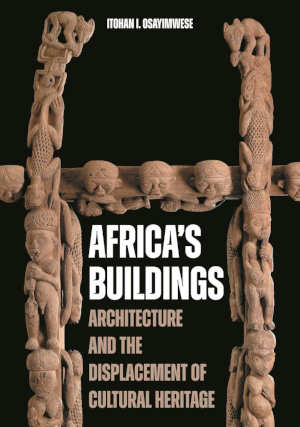Africa’s Buildings
Architecture and the Displacement of Cultural Heritage
- Author: Itohan I. Osayimwese
- Book type: African Architecture
- Publisher: Princeton University Press
- To be released: 7 October 2025
- Length: 296 pages
- Format: hardcover / ebook
- Prize: $ 35.00
- Order book from: Amazon / Bol
Itohan I. Osayimwese Africa’s Buildings review
- “Enlightening and relatable across cultural boundaries, Itohan Osayimwese presents an erudite rendering of African architectural history by demolishing preconceived Western definitions about the subject. The book’s carefully woven narratives demonstrate that attempts to cast Africa’s architectural production as purely traditional were and remain anthropological projects of race and class distinctions in modernity.” (Nnamdi Elleh, author of Architecture and Politics in Nigeria)
- “In this wide-ranging study of the looting and collecting of Africa’s architecture by European powers, Itohan Osayimwese brilliantly demonstrates the effects of such violent scattering of cultures, places, lives, and knowledge systems on our understanding of African architecture. A must-read for anyone interested in architecture or the problem of cultural restitution.” (Swati Chattopadhyay, author of Small Spaces: Recasting the Architecture of Empire)
Blurb book by Itohan I. Osayimwese about architecture in Africa
A groundbreaking history of Africa’s looted architectural heritage – and a bold proposal for the repatriation of the continent’s stolen cultural artifacts.
Between the nineteenth century and today, colonial officials, collectors, and anthropologists dismembered African buildings and dispersed their parts to museums in Europe and the United States. Most of these artifacts were cataloged as ornamental art objects, which erased their intended functions, and the removal of these objects often had catastrophic consequences for the original structures. Africa’s Buildings traces the history of the collection and distribution of African architectural fragments, documenting the brutality of the colonial regimes that looted Africa’s buildings and addressing the ethical questions surrounding the display of these objects.
Itohan Osayimwese ranges across the whole of Africa, from Egypt in the north to Zimbabwe in the south, and spanning the western, central, and eastern regions of the continent. She describes how collectors employed violent means to remove elements such as columns and door panels from buildings, and how these methods differentiated architectural collecting from conventional collecting. She shows how Western collectors mischaracterized building components as ornament, erasing their architectural character and concealing the evidence of their theft. Osayimwese discusses how the very act of displacing building parts like floor tiles and woven screen walls has resulted in a loss of knowledge about their original function and argues that because of these removals, scholars have yet to fully grasp the variety and character of African architecture.
Richly illustrated, Africa’s Buildings uncovers the vast scale of cultural displacement perpetrated by the West and proposes a new role for museums in this history, one in which they champion the repatriation of Africa’s architectural heritage and restitution for African communities.
Itohan I. Osayimwese is professor of the history of art and architecture and urban studies at Brown University, where she is an affiliate faculty in Africana studies and at the Center for Latin American and Caribbean Studies. She is the author of Colonialism and Modern Architecture in Germany and the editor of German Colonialism in Africa and Its Legacies.
